2024 Suzuki GSX-8R Review – First Ride

A middleweight sporty-bike without the backache
As I write this, in the year 2024, it’s dawned on me that there’s a whole generation of adults that have little to no memory of September 11, 2001. Some weren’t even alive yet, and those who were were too young to remember. One of, if not the, defining moment for my generation is just a page in a history book for today’s young adults, just as December 7, 1941 was for me. What’s lost for those who weren’t around to live through it goes beyond a page in a book, of course. It’s the experiences – the human connection – that are nearly impossible to convey unless you were there.
2024 Suzuki GSX-8R
A throwback to the days when sportbikes were comfortable and (somewhat) performance-oriented, the GSX-8R is Suzuki's entry into a very competitive field.
Editor Score: 83.5%
Engine | 18/20 | Suspension | 11.5/15 | Transmission | 7.5/10 |
Brakes | 8/10 | Instruments | 4/5 | Ergonomics | 9.5/10 |
Appearance | 9/10 | Desirability | 8/10 | Value | 8/10 |
Highs
- An all-day comfortable sportybike
- Usable torque early in the revs and excellent fueling make it a great street bike
- Looks pretty sharp (at least in my opinion)
Sighs
- Downshifts with the quickshifter aren't any good
- Pegs touch down early on track
- Is $9500 really considered affordable these days?
Motorcycles, however, can be a time capsule. Old bikes are still around for us to touch and feel and experience. In today’s evolving landscape of what it means to be a sportbike, we can look back through the years and study where it started to where we are now. Today, we think of sportbikes as pure race-bred machines thinly veiled as streetbikes because they have lights, mirrors, and a license plate. As fun as these race-focused machines are, we’ve finally come to realize this fun is only had in a very specific environment – the track. The highly-committed riding position and top-heavy power just aren’t any fun when all you’re trying to do is commute to the office.
It didn’t always be this way. In fact, we can draw a line back to when this all changed. Coincidentally, it was right around 9/11. The then-new R1 ushered in a hyper focus on the liter-class sportbikes and not long after the 600cc category followed suit. But do you remember what sportbikes were like before this? Clip-ons weren’t always so low, and engines made power in the usable rev range. Think Honda CBR900RR, or the various Suzuki GSX-R iterations before the year 2000.
The GSX-8R Is Born
In fact, this is exactly where Suzuki took inspiration from for its latest sportybike. The original 1985 GSX-R750, all the way through to the SRAD models – even the first-gen Hayabusa was used as inspiration. Fast forward to today and the gold rush of the sportbike era is gone. Nowadays, only a small subset of the riding public care to have supercar levels of performance at a fraction of the cost. What the people do want is performance, but they want usable performance wrapped in a package that won’t make their wrists hurt and their backs ache. Sound familiar?
Manufacturers have caught on to this trend with bikes like the Aprilia RS660, Honda CBR650R, Kawasaki Ninja 650, and the recently announced Triumph Daytona 660 just a few examples of performance-oriented sportybikes that are usable for the everyday rider. One thing they have in common is sporty appearances and intentions, but with higher bars, comfortable riding positions, usable power, and prices that are more reasonable than today’s sportbikes.
Now there’s one more model in the mix. Enter the new 2024 Suzuki GSX-8R. A fully-faired sport motorcycle built from the GSX-8S platform – Suzuki’s first all-new engine in a long time. In fact, the 8R was designed alongside the 8S from the start, with the same basic chassis and components designed all along with both a faired and naked model in mind.
The powerplant of choice is an obvious one, with the 776cc Parallel-Twin coming straight over from the 8S without any change in tuning. Suzuki says it makes 81 horsepower at 8,500 rpm and 57 lb-ft of torque at 6,800 rpm. More importantly with a streetable sportbike, there’s a significant amount of torque on tap early in the rev range.
Read more: 2023 Suzuki GSX-8S Review - First Ride
By this point, we’re used to hearing the moans and groans from people who despise the Parallel-Twin. “It’s boring,” they say. “They have no soul and they sound like sewing machines.” Well, yes, some Parallel-Twins really do sound like that and really are no fun to listen to. But some don’t. In fact, many of today’s Parallel-Twins don’t, partially because the manufacturers know they sound boring and soulless.
The key here is firing order. Parallel-Twins with their crankpins set 180º apart are the ones nobody likes, including me. Move the crankpins 90º apart from each other and you have an engine that sounds and feels completely different. The KTM 790 and 890 Dukes are spaced this way. So is the Yamaha CP2 engine found in the MT-07, R7, and Ténéré 700 (and R1, though it has four cylinders instead of two).
With the GSX-8R, just as with the 8S and the V-Strom 800 before it, the 776cc P-Twin also sees its crank pins set 90º apart from each other. From a performance standpoint you get an engine with very similar characteristics and sound as a V-Twin. Considering Suzuki’s history producing one of the most successful V-Twins in the SV650, we’re glad Suzuki chose to give it a better sound.
The big drawback with V-Twin engines is the amount of space the cylinders take up, as you have two jugs pointing in either direction underneath the fuel tank. Considering how tightly packaged motorcycles are these days, anything you can do to free up space is a big deal. To bring this point home, Suzuki included a graphic in its presentation informing us the 8R has over 200 electrical circuits compared to the 140 circuits the GSX-R750 had – in the year 2000. We take for granted the size of wiring harnesses, but with so many electrons running around, all those wires have to go somewhere, and the parallel-Twin configuration frees up a lot of space that can then be used to optimize the air intake, radiator, exhaust routing, and yes, the wiring harness routing. Like the 8S and V-Strom, the 8R features Suzuki’s Drive Mode Selector (SDMS), traction control, Ride-by-wire throttle, easy start (just tap the starter instead of holding it down), low-rpm assist, and bi-directional quickshifter.
The early development for the 8R started with the 8S, which means the frame and subframe surrounding the engine are the same. The clear difference is the fairings. Suzuki’s design and engineering staff, who were with us during this model introduction, explained that after installing the fairings – which also includes a new, super compact LED headlight – and repositioning the bars to be slightly lower and more forward than the 8S, the test riders were complaining about the suspension being too soft and the bike feeling unstable. Nothing had changed with the suspension from the 8S, but the added weight over the front end with the new positioning was enough to upset the handling balance.
This is the major difference between the 8S and the 8R – to find that balance again (you’re going to read that word a lot), Suzuki turned to Showa instead of KYB, which is used on the 8S, for suspension components. Up front is Showa’s SFF-BP, or Separate Function Front, Big Piston fork, with internals designed to Suzuki’s spec. Where the 8S fork offered a 20mm fork piston diameter, the BPF piston is 37.6mm. This greater diameter means there’s more surface area, which generates a higher damping force from a smaller stroke.
Next, the 8R incorporates straight-rate springs instead of the 8S’ progressive springs. The new spring rates in the 8R are actually softer than the 8S, but the valving is firmer to provide more control – and again, more balance – for the higher speeds and greater loads the 8R is likely going to experience.
Riding Impressions
If the GSX-8 formula sounds familiar to you, you’re not alone. From the moment the GSX-8S was launched, I thought all along that it was the SV650 reincarnate (even though the SV650 is still in production). The parallels are everywhere and I have to imagine that’s not a coincidence. If you start with a basic platform that’s adaptable to many different uses, you’re bound to have a winner on your hands – just as long as the engine is good.
That’s why I’ve been more interested in the 8R than I have about a lot of new bikes these days. My SV650 ownership should be well known by now (although I finally sold it after nearly two decades), and I, along with many others, were drawn to it because the bike was easy to ride, but also provided opportunities for it to grow with you as your experience grew. For someone who liked to upgrade their bikes as much as I liked to ride it, the SV650 was everything.
The GSX-8R (and 8S) give me those same vibes. From the moment you sit on it, you know the experience is going to be easy. Despite the forward bars compared to the 8S, the rider triangle is hardly aggressive and the knee bend, just like the seat, is all-day comfortable.
Tapping on the starter with Suzuki’s easy-start feature quickly brings to life the 776cc Twin, and although the stock exhaust muffles the sound a lot, there’s still a tiny bark hiding underneath. You don’t need to stretch the imagination far to know it would sound rowdy if allowed to properly roar. Following the SV650 formula, I can’t help but wonder what would happen if you let the engine breathe like it’s meant to and swap out a set of GSX-R forks (and shock). But I digress…
Road Manners
Day one of our two-day experience with the 8R saw us cutting up the local canyon roads near Palm Springs, California. Over 200 miles of riding was in store and very little of it would be in a straight line. That said, Mother Nature’s plans for the day didn’t agree with ours, but we’ll get to that in a minute. Suzuki’s entire goal for the 8R was to build an approachable sportybike less focused on the numbers and more focused on fun and comfort. It doesn’t take long to understand how easy the GSX-8R is to ride on the street. Clutch pull is light, and the low-rpm assist helps keep the revs up as you release the clutch to get moving. From there, the Twin’s torque greets you right away and moves you along quickly, but not alarmingly.
As we approached the bottom of Highway 74 and began our climb, two things came to mind quickly: first was how user friendly the engine is, as the torque and power is metered perfectly to what my right wrist was doing – and that was in A-mode. The second involves the bi-directional quickshifter. As the revs picked up, rowing up through the gears was easy with the quickshifter, just as it is in the 8S, V-Strom, and the 1000GT models. Unlike the 1000GT models, however, the downshifts on the 8R, just like the 8S and V-Strom, are notchy and anything but smooth. Even when trying to time my downshifts for the moment I’m completely off the throttle, the gearbox doesn’t want to change down smoothly with the autoblipper. Eventually, I resorted to using the clutch. It defeats the purpose, but at least I’m in control of how smooth power gets reapplied to the back tire.
The ascension up 74 revealed how nicely spaced the gears are, as you’re able to carry third through sixth gears for quite a while, making them very practical for everyday riding. After that, it was a little hard to notice much else about the bike since it was so. dang. cold. Unfortunately for us, our route would have us riding into a rain storm. So not only was it cold, but what would otherwise be some of the best canyon roads in Southern California would be less than ideal when wet.
In between shoving my left hand in between the engine and fairing to keep it warm (heated grips are available as an accessory), I did notice how comfortable the seat was. Riding at our mellow speeds meant we weren’t getting off the seat much, but I didn’t really mind it. The seat is really well padded where it counts and I didn’t need to stand up to get the blood flowing again. On the topic of comfort, Suzuki designers did a good job with the windscreen, as the air flowing over the windscreen is balanced with the stream coming up from the cutout in the bottom of the screen, resulting in smooth air all around me. Though I would personally opt for the accessory touring screen that’s taller, the standard one still works well for shorties like me.
Luckily, as the day went on, the rain took a break and the sun peeked through just enough to at least partially dry off the rest of the windy roads on our route. It was then that I realized I’d kept the bike in the A riding mode all along. Even though it’s the most aggressive, the power comes on so smoothly I didn’t feel the need to switch to any of the other modes (they all give you full power, just at different rates). The GSX-8R isn’t about pushing the pace, but as we wicked it up a bit, it’s surprising how well damped the suspension is. Budget suspension like this without any adjustments typically prefer to be finessed around bends rather than manhandled, and while that’s still true here, memories of flogging stock SV650s kept popping up in my head. Compared to those wallowing pogo sticks, the 8R feels downright planted!
Track Antics
If the street ride was just enough to give a taste of what the 8R can do, the real test of the bike’s performance would come on Day 2 at Chuckwalla Valley Raceway. With the recent announcement that the GSX-8R is now homologated for MotoAmerica Twins Cup, the timing couldn’t have been more appropriate. Fitted with Dunlop Q5S tires instead of the standard Dunlop RoadSport 2 rubber, we again revisit the word “balance.”
Without any clickers on the suspension available to me, the plan was to simply ride until the low fuel light came on. First, I wanted to see if I could physically do it. If so, how would I feel after, and if not, why? Would the bike be a wallowing mess and force me to pit after four laps, or could it actually handle the higher pace? The short answer is yes, I did burn through an entire tank of gas in one sitting, turning lap after lap. And you know what? It was eaassssyyyy. The GSX-8R couldn’t have been more comfortable. In fact, this is the first time that I can remember completing the fuel tank challenge on a racetrack and not once experiencing my hands going numb or tingling. I could have easily kept riding. Usually by the end of a tank I can’t wait to get off.
Credit for that goes to a few places. The obvious one is the higher bars. Without having to crouch over, my upper body stayed fresh for longer. Then there’s the seat. Despite one of the Suzuki staff rubbing a wax cleaner all over the seat while wiping down the rest of the bike, making for a slippery experience mid-corner, every corner, the actual comfort of the padding was enough to make me notice it. And while it’s true most pure track bikes have next to nothing for seats, stock seats on sportbikes don’t normally elicit such a response from me. Though if I do have one gripe, it’s not having enough real estate to scoot all the way back to get in a full tuck. My butt starts climbing up onto the passenger seat long before then.
But I think the real unsung hero in the fuel tank challenge goes to Suzuki’s patented dual counterbalancer system, effectively neutralizing the inherent vibrations from both cylinders of the Parallel-Twin engine. Even up high in the revs, the engine is silky smooth, and it’s the high-frequency buzz when riding on track that often leads to numb hands. There’s none of that here.
With the weather now in our favor, the track setting allowed me to focus more on the 8R than on simply staying warm and dry. Chuckwalla isn’t very tough on suspensions or brakes, as the pavement is smooth (for US standards) and there aren’t really any hard braking zones. The track favors corner speed, which tests the overall chassis. In addition to its smoothness, I was a little surprised at how the parallel-Twin revs fairly slowly. It might have been the super quiet exhaust distorting my perception, but it didn’t seem to me like I was frantically shifting. I’d have time to set my foot under the shifter for each upshift before eventually settling into fourth and fifth gear for most of the lap.
Going back to the quiet exhaust, experimenting with the correct gear to be in was tricky, as the lack of sound tricked me into thinking I needed a downshift. But as I looked at the tach and saw the engine was in the meat of its powerband, I came to realize the P-Twin doesn’t need to be sitting near redline – and the overall gearing was perfect for Chuckwalla. As the rubber started to show obvious signs of tearing, the engine’s slow-revving nature made it easy to correct a small spin-up if I got too greedy on the throttle too early while leaned over. Simply ease off the gas or stand the bike up a little to put more rubber on the road.
Maybe because it’s hard to upset the bike, or it’s easy to correct it, but at no point did traction control intervene for me. Remember earlier how I mentioned Chuckwalla favors corner speed and the GSX-8R prefers finesse? It turns out, those two attributes mean this bike is well suited to this track. Getting up to speed is easy as you can effectively leave the bike in fourth gear for nearly the entire track. You only need to dab the brakes to scrub off a little speed and transfer weight to the front.
When you do, the steel tube chassis tracks through a corner predictably. It certainly isn’t as precise as a scalpel, but it goes where you want it to as long as you ease into those commands instead of demanding them right away. The real limiting factor being the pegs touching the ground really early. If you have intentions on tracking an 8R, higher rearsets should be high on your list of upgrades. Also, the 8R isn’t a light bike, at least not in its category. At a claimed curb weight of 452 lbs, she’s a porker compared to some of its rivals, and even though I didn’t have them ready to try side-by-side, the 8R wasn’t the quickest to lean over. The weight certainly doesn’t help.
Lasting Impressions
Still, would I give up some weight for a comfortable ride? In this case, absolutely. After a full day of riding on track, my impressions largely mirror my thoughts on the street. Overall, the GSX-8R is so perfectly balanced as a sum of its parts. For my 160-pound frame, the stock suspension and chassis are well matched to the pace offered by the stock engine power. Nothing overwhelms the other. Same goes for the brakes. Granted, Chuckwalla isn’t a great test bed for putting budget suspension or brakes through its paces, but I keep coming back to that word balance as an apt descriptor. There’s a zen-like quality to me for how well the individual components work in perfect harmony together. However, add weight and that balance goes out the window, as evidenced by the extremely shredded tires and destroyed footpegs of some of the…uhh…heavier journos attending this intro. Similarly, if you start adding power to the engine, that balance will also be disrupted.
By now you’ve probably figured out the answer to whether or not Suzuki has succeeded in its objective – that is, to bring back the comfortable sportybike. You may have also noticed I keep adding the letter Y to the word. That’s not an accident. It’s silly to call the GSX-8R and those in this category a “real” sportbike, but we also can’t deny their sporting attributes. If you still want a sportbike, this isn’t the bike for you. Go look at the GSX-R600, 750, or 1000 – Suzuki’s not going to stop making them.
But, if you’re like me, and you find this middleweight sportybike segment to be your sweet spot for an everyday, do-it-all bike… your decision just got a little bit harder. The GSX-8R is no doubt fun, sporty, and easy to ride, but let’s take a look at how it stacks up to some of its rivals in a few key spots:
Suzuki GSX-8R | Aprilia RS660 | Triumph Daytona 660 | Honda CBR650R | Kawasaki Ninja 650 | |
|---|---|---|---|---|---|
Price | $9,439 | $11,499 | $9,195 | $9,899 | $8,299 - $8,899 |
Engine | 776cc Parallel-Twin | 659cc Parallel-Twin | 660cc Inline-Triple | 649cc Inline-Four | 649cc Parallel-Twin |
Seat Height | 31.9 in. | 32.3 in. | 31.88 in. | 31.9 in. | 31.1 in. |
Rake | 25º | 24.1º | 23.8º | 25.5º | 24.0º |
Trail | 4.09 in. | 4.1 in. | 3.2 in. | 4.0 in. | 3.9 in. |
Curb Weight (claimed) | 452 lbs | 403 lbs | 443 lbs | 445 lbs | 423.4 lbs (ABS)/ 421.2 lbs (non-ABS) |
Wheelbase | 57.68 in. | 53.9 in. | 56.12 in. | 57.0 in. | 55.5 in. |
As you can see, this category now has some stiff competition. Kerry Graeber, Suzuki USA’s Senior VP of Sales and Marketing, revealed to me that, while GSX-8S and V-Strom 800 sales are neck and neck with each other, he expects the 8R to surpass them both. There’s no doubt Suzuki’s hit all its marks with the GSX-8R, but will it be enough? I see a comparison test looming in our (admittedly distant) future…
Troy’s Street Gear
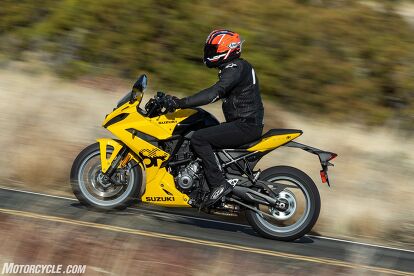
- Helmet: Arai Corsair-X Vinales-6
- Jacket: Alpinestars GP Plus V4
- Airbag: REV’IT! Avertum Tech-Air
- Pants: Alpinestars Copper v3 Riding Jeans
- Gloves: Alpinestars Equinox Gore Tex X-trafit (Discontinued)
- Boots: Alpinestars Superfaster Shoes
Troy’s Track Gear

- Helmet: Arai Corsair-X Vinales-6
- Suit: Alpinestars GP Tech V4
- Airbag: REV’IT! Avertum Tech-Air
- Gloves: Racer High Racer
- Boots: Alpinestars Supertech R
2024 Suzuki GSX-8R Specifications | |
|---|---|
MSRP | $9,439 |
Engine Type | 776cc, 4-stroke, liquid-cooled, DOHC Parallel-Twin |
Bore x Stroke | 84.0 mm x 70 mm |
Compression Ratio | 12.8:1 |
Fuel System | Fuel injection |
Starter | Electric |
Lubrication | Force-fed circulation, wet sump |
Ignition | Electronic ignition (transistorized) |
Spark Plug | Iridium type x 2 |
Clutch | Wet, multi-plate type |
Transmission | 6-speed constant mesh |
Final Drive | O-ring style chain, 525 x 118L |
Front Suspension | Showa 41mm SFF-BP, no adjustments available, 5.1 inches of travel |
Rear Suspension | Showa single shock, coil spring, oil damped, preload adjustable, 5.1 inches of travel |
Front Brakes | Nissin radial-mount 4-piston calipers, twin 310mm disc, ABS-equipped |
Rear Brakes | Nissin 1-piston, single disc, ABS-equipped |
Front Tire | 120/70ZR17M/C (58W), tubeless |
Rear Tire | 180/55ZR17M/C (73W), tubeless |
Headlight | Mono-focus LED x 2 |
Tail Light | LED |
Turn Signals | LED |
Length | 84.8 inches |
Width | 30.31 inches |
Height | 44.69 inches |
Rake/Trail | 25° / 4.1 inches |
Wheelbase | 57.7 inches |
Ground Clearance | 5.7 inches |
Seat Height | 31.9 inches |
Curb Weight | 452 pounds (claimed) |
Fuel Capacity | 3.7 US gallons |
Color | Metallic Triton Blue, Pearl Ignite Yellow, Metallic Matte Sword Silver, |
Warranty | 12-month unlimited mileage limited warranty |
Extension | Longer coverage periods with other benefits available through Suzuki Extended Protection (SEP) |
We are committed to finding, researching, and recommending the best products. We earn commissions from purchases you make using the retail links in our product reviews. Learn more about how this works.
Become a Motorcycle.com insider. Get the latest motorcycle news first by subscribing to our newsletter here.

Troy's been riding motorcycles and writing about them since 2006, getting his start at Rider Magazine. From there, he moved to Sport Rider Magazine before finally landing at Motorcycle.com in 2011. A lifelong gearhead who didn't fully immerse himself in motorcycles until his teenage years, Troy's interests have always been in technology, performance, and going fast. Naturally, racing was the perfect avenue to combine all three. Troy has been racing nearly as long as he's been riding and has competed at the AMA national level. He's also won multiple club races throughout the country, culminating in a Utah Sport Bike Association championship in 2011. He has been invited as a guest instructor for the Yamaha Champions Riding School, and when he's not out riding, he's either wrenching on bikes or watching MotoGP.
More by Troy Siahaan







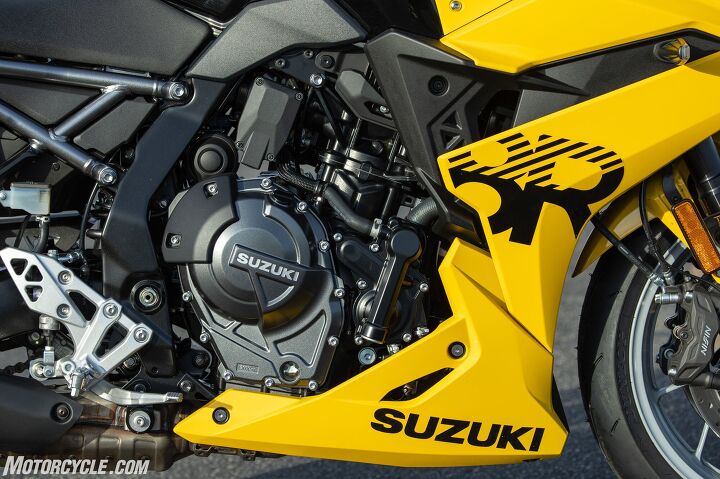




































































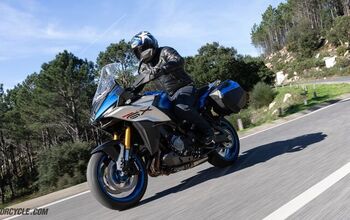
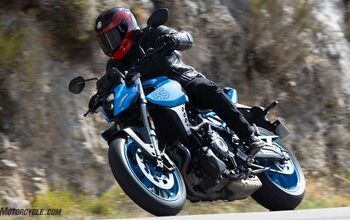









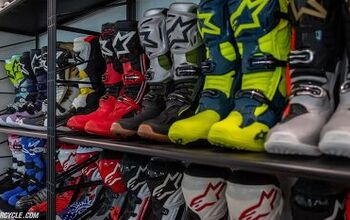



Comments
Join the conversation
How in the world did they make this bike weigh so much? I have a 2013 BWM R 1200 R that weighs about the same.
Notice I said "about". An 8% difference isn't a whole lot considering one is a 776cc "sporty" bike and the other is a naked touring bike. You'd expect the Zuke to be SUBSTANTIALLY lighter. 40lbs difference can be found in the riders.